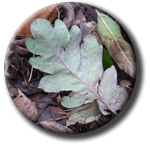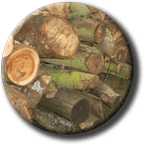New Trees
Choosing what trees and where
The trees you plant will probably outlive you, so it is
worth choosing carefully what you plant and where. This page concentrates on
planting trees in gardens and similar places around people. For a much more
detailed guide, including lots of information about planting trees in many situations,
we recommend the National Small Woodlands Association Information Sheet 13 -
Tree Planting.
The main constraint in most gardens is lack of space. Always
remember that trees grow! Don’t make the mistake of thinking that you
can stop a tree from growing. Whatever you are planting, find out how big it
may get, and plant it where it will have enough room to grow, so that you won’t
need to have it pruned.
• Only plant trees where they will be unlikely
to cause direct damage or subsidence (indirect damage).
• Buildings: don’t plant trees close enough to overhang.
• Boundary walls: plant 2 m or more away.
• Overhead electricity lines: these can be very dangerous, don’t
plant trees anywhere they could grow big enough to touch them.
• Overhead telephone wires: try to avoid these too.
• Leaking drains: get any leaks repaired (roots cannot get into sound
unbroken drains).
• Paving: tree roots can lift or crack lightweight things like slabs and
blocks (they can’t directly lift heavy things like houses!) - plant trees
at least 2-3 m away, or use something loose and permeable like gravel.
• Indirect damage: the risk of subsidence depends on the interaction between
soil, foundations, weather, and vegetation. Trees can increase the risk because
of the water they take up from the soil. Ask a tree consultant and building
surveyor or structural engineer for advice before planting trees close to buildings
on clay soils.
 Native
trees are wildlife, if given the chance to get there by themselves (usually helped
by wind or birds), and they are usually better than exotic trees as habitats for
other wildlife. To let trees plant themselves, leave part of your garden unmown
and undug, see what comes up (this will usually depend on what trees are nearby,
including non-native trees), and then choose what you want to keep and what to
remove. Naturally self-set trees are usually more wind-firm than planted trees,
and self-set woods are usually better for wildlife than plantations.
Native
trees are wildlife, if given the chance to get there by themselves (usually helped
by wind or birds), and they are usually better than exotic trees as habitats for
other wildlife. To let trees plant themselves, leave part of your garden unmown
and undug, see what comes up (this will usually depend on what trees are nearby,
including non-native trees), and then choose what you want to keep and what to
remove. Naturally self-set trees are usually more wind-firm than planted trees,
and self-set woods are usually better for wildlife than plantations.
If you want to get trees in more quickly, or in a more planned
way, you can plant them. Either buy your trees from a nursery who can guarantee
local provenance, or grow your own from local trees. There are about 60 species
of trees and shrubs which are native to Britain. These are the species that
arrived here after the last Ice Age without human help. (Evidence for this comes
from field archaeology, especially pollen records, study of existing species
and their behaviour, and written records). Some species like English elm may
have been brought by people at the same time, and some like sessile oak may
also have been planted. Not all native trees are suitable for planting - do
not plant rare species as this will make their natural history meaningless.
Only buy native trees and shrubs from nurseries which can guarantee local provenance.
This means that they have been grown from seed from trees growing in the region
they are to be planted back in and so are genetically local trees. This means
they will be suited to the local conditions and other wildlife will be adapted
to them. If you will be planting in the wild and if you cannot get trees of
local provenance, think very carefully before you plant native trees - they
will in effect be exotics and planting them may upset the local ecology. If
in doubt you should seek the advice of some local experts who know what is native
to your area - the local Wildlife Trust is a good place to find some. Native
trees for Southern England include:
| oak (pedunculate) Quercus robur |
oak (sessile) Quercus petraea |
| English elm Ulmus procera |
wych elm Ulmus glabra |
| birch (silver) Betula pendula |
ash Fraxinus excelsior |
| maple Acer campestre |
cherry Prunus avium |
| hazel Corylus avellana |
holly Ilex aquifolium |
| osier Salix viminalis |
blackthorn Prunus spinosa |
| birch (downy) Betula pubescens |
aspen Populus tremula |
| hedgerow hawthorn Crataegus monogyna |
alder Alnus glutinosa |
If you are planting in a garden native species are not
the only suitable trees - exotic trees from beyond Britain can give all sorts
of other possibilities of shape and texture, colour, taste and smell. So don’t
be restricted in your choice - there are thousands of different tree species
around the world, many are already growing here, and there are probably many
more that could flourish. Get inspiration from books, nursery catalogues, TV,
and visits to other gardens. Choose trees which will be adapted to the conditions
in your garden, including soil type, aspect, windiness, exposure to salt spray.
Do not plant trees which will invade sensitive local habitats - for example,
do not plant sycamore or Norway maple near woods or other sensitive habitats;
do not plant holm oak near chalk grassland.
You can grow trees for food, especially nuts and fruit.
You can also grow other plants for food and to help your fruit and nut trees,
using ideas from companion planting, forest gardening and permaculture. You
can get advice from:
• Ken Fern: Plants for a Future Permanent Publications
(1997)
• Robert Hart: Forest Gardening Green Books (1991)
and from several magazines, including "Agroforestry
News", published quarterly by Agroforestry Research Trust, 46 Hunters Moon,
Dartington, Totnes, Devon, TQ9 6JT and "Permaculture", published by
the Permaculture Association, Hyden House Ltd, The Sustainability Centre, East
Meon, Hampshire GU32 1HR.
 All
trees can be used for some craft purposes, but some have special uses and some
are grown by specialist nurseries. This list includes willows used for basketry.
(Be very careful choosing where to plant fast-growing species like willows and
poplars - they may grow so fast and take up so much water that they cause damage.
Only plant them if you have enough room.)
All
trees can be used for some craft purposes, but some have special uses and some
are grown by specialist nurseries. This list includes willows used for basketry.
(Be very careful choosing where to plant fast-growing species like willows and
poplars - they may grow so fast and take up so much water that they cause damage.
Only plant them if you have enough room.)
You can also use any tree for fuel, though some burn better
than others and all will burn better when the wood has dried out. Use a clean-burn
woodburning stove. Woods used to be managed as coppice for fuel and crafts,
with standards for timber. However, to do this sustainably you will need many
acres of woodland and a lot of hard work!
Garden centres usually only have a small stock of trees,
so you will have more choice if you order trees from nurseries directly (use
The Royal Horticultural Society’s yearly Plant Finder - many nurseries
send plants by mail order). Buy young trees - they are more vigorous than older
trees and will recover faster from transplanting, and soon settle down and grow
quickly.
If you want to plant at least 0.25 ha, you may be able to apply
for money from the Woodland Grant Scheme - contact the Forestry Authority for
details.
Deciduous trees are best planted during the dormant season,
usually from October-March, when the weather is reasonably mild and moist. The
best time is November, so the trees have a winter to settle in before the growing
season. Evergreen trees are best planted at the end of the dormant season or
at the beginning of the growing season, usually March - May. Plant your trees
as soon as possible after they arrive. The largest size you would usually need
to plant, is a 150 - 180 cm tree known as a whip. Larger trees cost a lot more
and can be a lot of bother. Better to buy five whips for the same price - even
if four die you've still got a tree.
• Dig planting pit deeper and wider than root spread,
down to free-draining soil.
• Break up bottom and sides of planting pit.
• Plant tree at same depth as in nursery-soil mark on stem level with
soil.
• Spread roots out in planting pit.
• Spread backfill of soil and compost around roots and firm gently.
• Use a tree shelter or guard if there are rabbits or deer in or near
your garden - it may be self-supporting or include a cane. In windy gardens,
or for larger trees, use a stake - drive it into the ground before planting
the tree, so that stake is 1/3 height of tree.
• Spread mulch in 2-3" layer for at least 3-4' diameter around tree.
• Water tree well after planting.
Keep a clear weed-free circle at least 3-4' (1m) around
each tree for the first two or three years - weeds compete with trees, especially
for water. Pesticides can be used or, if you prefer, a mulch or mulch mat. A
mulch mat is a mat placed around the tree to prevent the growth of weeds by
keeping the light from them. Mats can be quite cheap, and you can make your
own from reclaimed material such as old carpet or plastic sheeting.
If you use mulch, top it up to keep it 2-3" (5-8 cm) deep.
Use biodegradable mulch such as bark or composted wood chips - a mulch mat can
be cost-effective but ugly and needs to be cleared away. Water trees throughout
their first two or three growing seasons, until they get established. Check
any ties regularly, and loosen them as the trunk expands. Remove any stakes
after the second or third winter. If a tree grows awkwardly, it is better to
prune it while it is still young to encourage a better shape.
by Rowan Adams, former Tree and Landscape Officer,
for the Isle of
Wight Council. Reproduced by kind permission.

 Native
trees are wildlife, if given the chance to get there by themselves (usually helped
by wind or birds), and they are usually better than exotic trees as habitats for
other wildlife. To let trees plant themselves, leave part of your garden unmown
and undug, see what comes up (this will usually depend on what trees are nearby,
including non-native trees), and then choose what you want to keep and what to
remove. Naturally self-set trees are usually more wind-firm than planted trees,
and self-set woods are usually better for wildlife than plantations.
Native
trees are wildlife, if given the chance to get there by themselves (usually helped
by wind or birds), and they are usually better than exotic trees as habitats for
other wildlife. To let trees plant themselves, leave part of your garden unmown
and undug, see what comes up (this will usually depend on what trees are nearby,
including non-native trees), and then choose what you want to keep and what to
remove. Naturally self-set trees are usually more wind-firm than planted trees,
and self-set woods are usually better for wildlife than plantations. All
trees can be used for some craft purposes, but some have special uses and some
are grown by specialist nurseries. This list includes willows used for basketry.
(Be very careful choosing where to plant fast-growing species like willows and
poplars - they may grow so fast and take up so much water that they cause damage.
Only plant them if you have enough room.)
All
trees can be used for some craft purposes, but some have special uses and some
are grown by specialist nurseries. This list includes willows used for basketry.
(Be very careful choosing where to plant fast-growing species like willows and
poplars - they may grow so fast and take up so much water that they cause damage.
Only plant them if you have enough room.)